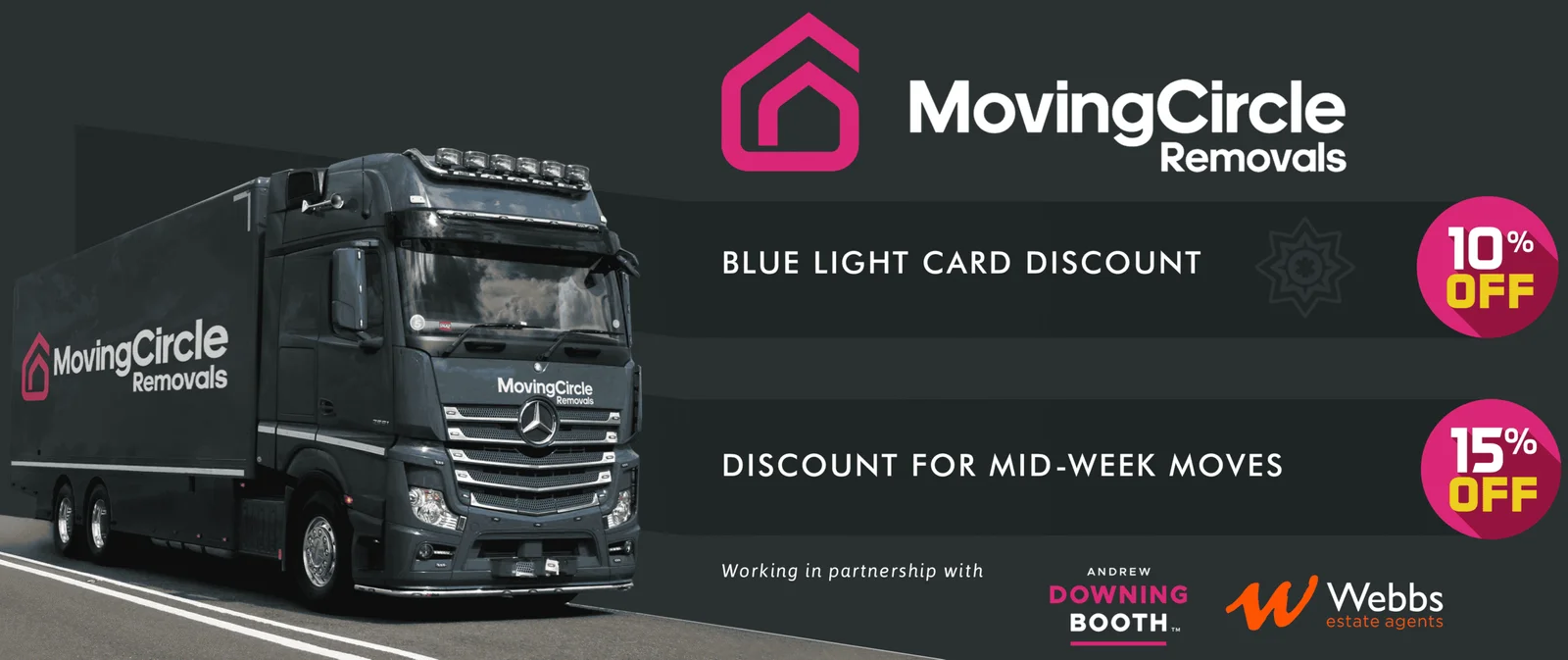Business Relocation

Understanding Business Relocation – Why It Matters More Than You Think
Business relocation isn’t just about moving desks, chairs and boxes from one address to another — it’s a complex process that can impact your operations, staff, clients, and long-term success. Whether you’re upgrading to a larger space, downsizing for efficiency, or shifting to a better location, how you handle the move can make or break your business momentum.

10% Blue light card discount
We support all members of our armed forces residing in, NHS, police, etc. by offering a flat rate 10% discount to Blue Light Card holders.
15% Mid week move discount
Removals companies get booked up fast on Thursdays & Fridays; we incentivise a Monday-to-Wednesday move with a 15% discount.
Book now, pay the balance after you’ve moved in
Booking Moving Circle Removals and Storage after receiving your quotation is simple; just click the green button to reserve your move date.
What Is Business Relocation?
In simple terms, business relocation means moving your entire workplace — including people, equipment, documents, and infrastructure — to a new physical location. It could be across the street, across town, or even across the country. But regardless of the distance, the challenges stays similar: planning, packing, and getting everything running again with as little downtime as possible.
Some people thinks it’s just about hiring a van and loading up the furniture, but that’s only a small part of it.
Why Businesses Choose to Relocate
There’s many reasons a company might choose to relocate, and each one brings its own set of goals and obstacles. Common motivations include:
- Growth: Needing more office space for new hires or departments
- Cost Reduction: Moving to a more affordable area or smaller premises
- Location: Getting closer to customers, suppliers, or transport hubs
- Image Upgrade: Relocating to a modern or more professional space
- Mergers or Restructuring: Combining multiple branches or streamlining operations
Each of these reasons requires different planning and timing. For example, a fast-growing startup might need flexibility and speed, while a long-established firm may need detailed coordination across departments.

Challenges You Should Expect
No matter the size of your company, relocating a business isn’t without its bumps. Here’s a few of the most common issues:
- Downtime: Every hour your business isn’t working, you’re losing money.
- IT and Connectivity: Getting your systems back online quickly is crucial.
- Staff Disruption: Your employees might face longer commutes or changes in their routines.
- Client Communication: If customers don’t know you’ve moved, you could lose them.
- Logistics Confusion: Coordinating equipment, furniture, and deliveries takes effort.
Skipping over these areas or rushing the process often leads to mistakes. We’ve seen companies forget to notify suppliers or lose files in the move — mistakes that cost time and trust.
The Role of Professional Movers
This is where Moving Circle Removals & Storage comes in. Working with a company that specialises in business relocation helps reduce risks, avoid unnecessary downtime, and ensures your team gets back to work quickly.
A professional team:
- Helps plan every stage of the move
- Packs and protects your equipment properly
- Offers flexible moving times (like evenings or weekends)
- Handles heavy or sensitive items with care
- Supports with setup at the new location
And most importantly, they know how to do it without disrupting your day-to-day operations.
Planning a Smooth Business Relocation – Step by Step
Once you’ve decided to relocate, the real work begins. A successful business relocation doesn’t happen by accident. It takes proper planning, timing, and the right support team.
Start Early, Plan Everything
One of the most common mistakes is underestimating how long a business relocation can take. Planning should ideally begin 3 to 6 months before the actual move — longer if you’re a big company. The earlier you start, the less chances there are for surprises.
Start with a relocation checklist. It should include:
- Your move date
- Inventory of all items (equipment, files, furniture)
- Roles and responsibilities for team members
- Moving company research and booking
- Communication plan for staff and clients
Some companies thinks they can sort it all last-minute. But rushed moves cause delays, missed equipment, and staff confusion.
Get Staff Involved
Relocation affects everyone — so include your staff in the process. Let them know the schedule early, and assign tasks where needed. IT might handle server prep, admin might pack files, and managers can help coordinate teams.
Clear internal communication helps reduce stress and ensures everyone is on the same page. You’d be surprised how often businesses forget to update their own team about moving details.

Book an online video removals survey at your convenience
Book a video call consultation with us, so we can assess the volume of what you would like to be moved and gather information needed in order to provide an accurate price. Alternatively, call us on 0800 0472607 to book a home visit.
However you book your removals survey, we can help tailor our service to your needs.

Choose the Right Moving Partner
You don’t just need any movers — you need movers that understand business relocation. That means:
- Handling sensitive IT equipment
- Moving during off-peak hours (evenings/weekends)
- Offering packing, transport, and reinstallation
- Supporting with insurance or temporary storage
Moving Circle Removals & Storage is experienced with business moves across the UK and understand the pressure you’re under. We help companies move without disrupting their operations.
If you choose the wrong movers, you might end up with scratched equipment, delays, or even lost files. Don’t risk it.

Protect Your Tech and Data
Servers, computers, phones — they’re the heartbeat of your business. Make sure IT systems are properly backed up and carefully disconnected. Label cables, store small parts like mouse and chargers in zip bags, and avoid mixing departments’ tech.
You’d be shocked how many companies lose important cables or hard drives during relocation just because they packed in a rush.
Communicate with Clients and Suppliers
Don’t forget to let your customers and vendors know that you’re moving. Update your address on:
- Google Maps and Business Listings
- Your website’s contact page
- Invoices and email signatures
- Any ongoing projects or contracts
A quick post on social media and a short email blast can also help you keep clients in the loop. Not informing customers can create confusion and make you look unorganised.
Moving Day and Settling Into Your New Business Location
After all the planning, it’s time to actually make the move. But your business relocation isn’t finished until you’re fully set up and running again. How you handle moving day and the days after can make a big difference in how quickly your business gets back on its feet.

Make Moving Day as Smooth as Possible
Have a point person on-site — someone who knows what’s going where. Make sure all boxes are labeled clearly, especially anything fragile or IT-related. Keep essential items like documents, laptops, and chargers close. Those things tends to disappear when you need them the most.
If possible, stagger your move. Some businesses move one department at a time so work keeps going without full shutdown.
Working with Moving Circle Removals & Storage means your move will be handled efficiently. Our team knows how to move businesses with care, precision, and on schedule.
Prioritise What to Unpack
Don’t try to unpack everything on Day One. Focus on:
- Workstations and desks
- IT setup (computers, printers, Wi-Fi)
- Phones and key communication tools
Other items like decor, kitchen setups, or storage can wait a bit. The main goal is to get your team working again — not to hang wall art.
Do a Post-Move Check
Once everything is unloaded, walk through the space and check for damages or missing items. Things sometimes gets misplaced during moves, especially if multiple teams are involved.
Ask your moving company for a final inventory check. If you’re working with professionals like Moving Circle, you’ll already have detailed tracking in place.
Help Staff Settle In
A new space can feel unfamiliar. Take time to help employees adjust — maybe hold a short meeting, give a mini-tour, or just offer support. Even simple things like showing where the coffee machine is can make a difference.
Sometimes staff feel a bit lost after a move, especially if they wasn’t involved in the process. A smooth first week builds morale and reduces stress.
Update the World
Don’t forget to let your clients and community know you’ve moved! Post updates on:
- Your website
- Social media
- Local directories
- Business cards and email footers
Many businesses forget this step, which leads to lost opportunities or frustrated customers.
Final Thoughts
A business relocation isn’t just a change of address — it’s an opportunity for growth, fresh energy, and new beginnings. With careful planning, the right team, and support from experienced movers like Moving Circle Removals & Storage, your transition can be smooth and stress-free.
If you’re planning a move soon, don’t wait till last minute. Contact our team today and see how we can help you relocate better, faster, and smarter.
Subscribe to our Emails
Sign to our weekly newsletters if you are an Estate Agent, Removals company requiring Trade services or a business regularly dealing with client relocations
Reviews
[reviews-feed feed=1]








Today’s Articles
Choose a company that is Legal
Choose a company that’s Legal When planning a move—whether it’s across town or to another country—ch…
Best Movers in Stafford
It’s Subjective but here are some facts. There are lots of moving companies in Stafford, but don’t m…
Why overloading is Bad
Why overloading is bad Overloading a 3.5-tonne (3.5t) van may seem like a way to save time or i…
